The Ethics and Aesthetics of AI for Textile Artists by Louise Krasniewicz
May 19, 2023
Artificial Intelligence (AI) image generation programs have recently become available to the general public. Debates about the ethics and aesthetics of these generated images have exploded across mainstream media as well as art forums. There seems to be a general concern about AI generated art images (as well as videos and texts) that appear to be trying to fool the viewer or reader into thinking they are simply the work of a human representing real world creative activities.
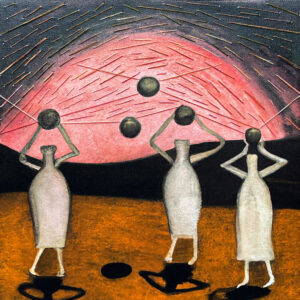
Louise Krasniewicz, Juggling Milk Bottles, 2023. Photoshopped and hand stitched. Text Prompt: “A Max Ernst painting of 3 witches juggling milk bottles at sunset in a field.”
For textile and mixed media artists this is a curious discussion. Since fiber and textile-based arts are tactile and usually one-of-a-kind, they are not subject to the same anxiety as are relatively easily reproducible forms like graphic designs, videos, and photos. But more than being comforted that their works cannot be auto-generated by AI programs, textile artists have an opportunity to demonstrate just how useful a tool like AI can be.
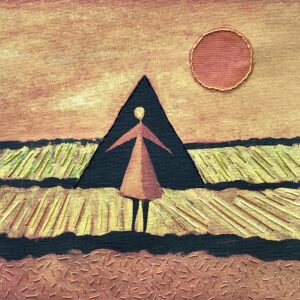
Louise Krasniewicz, On Tiptoes, 2023. Photoshopped and hand stitched. Text Prompt: “A Russian Constructivist painting of an old witch standing on her tiptoes in an orange field.”
AI image generation is based on a simple process. A text prompt in natural language is entered into an AI program (there are several online) which uses a database “trained” on billions of images and captions that have been gathered from numerous sources (Google, Pinterest, auction sites, clip art collections, Wikimedia, Instagram, etc). The new image generated is not a copy of any one image in the database and even images generated in the style of a well-known artist does not copy the original artwork, only aspects of its style. Think of a Cubist style work: it will be cut up into colorful blocks with varying perspectives but will not replicate the content of a Picasso or Braque.
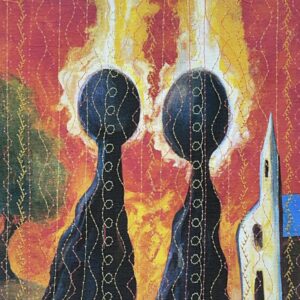
Louise Krasniewicz, Two Witches Laughing, 2023. Machine stitched. Text Prompt: A Max Ernst painting of the backs of 2 old witches laughing in front of a church on fire. Another good example of how the AI generator does not fully comprehend complex human language since the figures are on fire instead of the church.
For textile artists the generation of multiple, instantaneous variations of an idea in the artist’s head into a visual form can be a gift for further creative productions. Once generated (and edited since most of the images have wonky glitches) an AI image can be printed at any size and on any medium, or traced, cut up, manipulated, stitched, collaged, sculpted, painted, made into a poem or essay. It can just be an inspiration for a more advanced work, just like the inspirations from visiting a museum exhibit, studying the history of art, or taking a workshop.
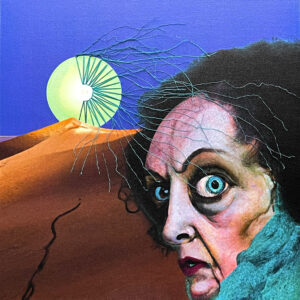
Louise Krasniewicz, An Old Witch Lost in the Desert #1, 2023. Photoshopped and hand stitched. Text Prompt: “An old witch lost in the desert followed by a blue eyeball in the style of Max Ernst.”
One goal of the Surrealist movement in the early 20th century was the uninhibited, spontaneous expression of the imagination which was often found in dreams and free-association activities. It is not a coincidence that one of the popular AI online programs is called the “Deep Dream Generator” and produces somewhat stereotypical images that evoke Surrealist concepts of imaginary dreamlike worlds. AI generation works if we use it as a first-step tool for creating a work, not a generator of finished art. There will always be a nostalgia for a pre-technology past but textile artists can provide a hybrid form: carving out a best-practice use for images generated with both human and computer input.
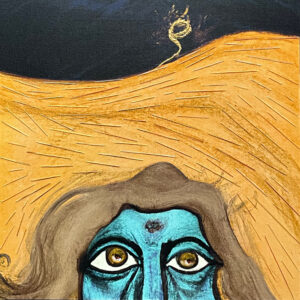
Louise Krasniewicz, An Old Witch Lost in the Desert #2, 2023. Hand stitched. Text Prompt: “An old witch lost in the desert followed by a blue eyeball in the style of Max Ernst.”
Is all this ethical? The language used in criticism of AI programs calls the collection of images that have been posted online “scraping” or “stealing” or “harvesting” by robots or other non-human means. Many artists are surprised to find that programs they signed on to use (Instagram is the best example) state in their user policy that the company will share and sometimes sell the images posted on their site, even if the artists retain copyrights to the works. They have been doing this for years and only recently can artists opt out of having their work shared. Instagram’s policy, however, remains the same.
By the way, the US Copyright office has ruled that a computer algorithm itself cannot copyright a work that is completely generated by a machine so they will need our artistic guidance for at least a bit longer!
Some AI generation programs:
- https://openai.com/dall-e-2/#demos
- https://deepdreamgenerator.com/
- https://playgroundai.com/
- https://creator.nightcafe.studio/
–Louise Krasniewicz is a retired professor of anthropology and former director of a digital media lab who has returned to being a full-time artist. She works in mixed media, fiber arts, and miniatures.

1 Comment
Susan Purney Mark says
May 19, 2023 at 9:54 am
An interesting read….I am fascinated by the use of AI and often use it in my writing to double check grammar and sentence structure, I don’t however ask it to generate content. But I wonder how long it will be before we see AI used in textiles…I’m thinking of digital looms (not an expert on this, so don’t know how it could be done) or even embroidery machines or any technique that uses a connection to computer technology?